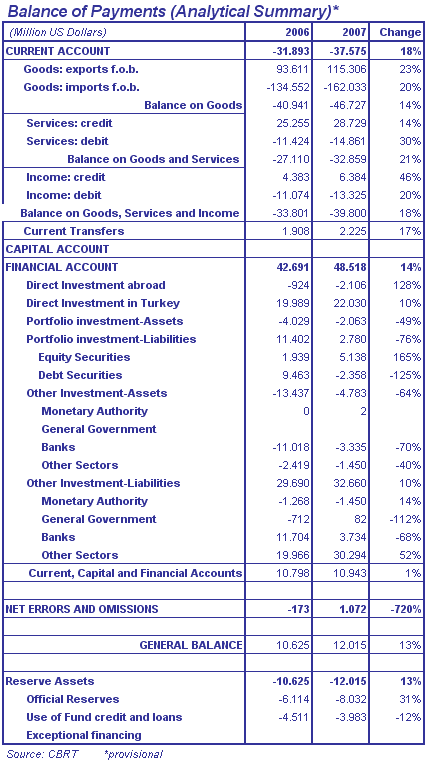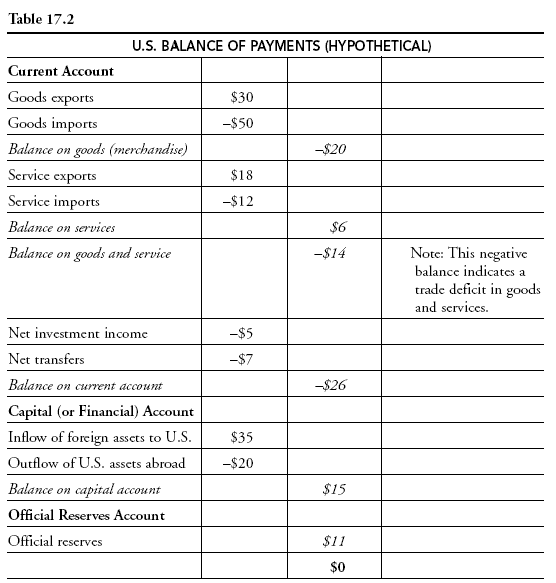Balance of Payments
Post on: 16 Март, 2015 No Comment

Balance of Payments: Fundamental Concepts
Plus or Minus?
One way to think about international transactions is to ask whether a transaction requires a payment from a foreigner, or a payment to a foreigner. Ultimately the payments to and from foreigners have to balance, with any residual accounted for by changes in reserves.
(Accountants have a tidy language for this: they call any transaction that requires making a payment to someone else a debit. and any transaction that requires someone else to make a payment to us a credit. Dont worry about learning this accountants terminology, but the distinction is useful, and its on this basis that we give things plus or minus signs in the BoP accounts.)
Activities that require payments from foreigners to us (or sources of foreign exchange)
These take a plus sign in the accounts.
- Exports (Example: the export of an airplane to Singapore requires the purchaser in Singapore to make a $2 million payment to the U.S. manufacturer.) Transfers from foreigner s (public and private) (Example: Spain sends $1 million in aid to flood-stricken Pennsylvania, which requires making a payment to someone in the U.S.) Income from foreigners (or Factor Services) (Mainly dividend or interest payments arising from foreign assets held by U.S. citizens) (Example: Argentina pays $8 million in interest on a $100 million loan it received two years ago from Citibank) Financial transactions in which foreigners buy financial assets from us.
Example 1: German investors purchase $200 million of U.S. Treasury bonds from people in the U.S. who currently own those bonds. Completing that sale means paying for them (you might think of this as an export of IOUs). In this case, the result is that foreigners total holdings of U.S. assets rise.
Example 2: U.S. investors who currently own $100 million in French corporate bonds sell those bonds to French investors. Again, completing that sale requires making a payment to people in the U.S. In this case, the result is that U.S. citizens total holdings of foreign assets fall.
Example 3: Someone in the U.S. borrows from a Canadian Bank. You can think of borrowing from a bank as selling them your IOU: the loan sits on the banks books as the banks asset. So this brings money in.
Example 4: A foreigner repays the principal on a loan they had taken out earlier from a U.S. bank. You can think of repaying a loan as buying back the IOU that you gave the bank when you borrowed.
Activities that require payments to foreigners by us (or uses of foreign exchange)
These take a minus sign in the accounts.
- Imports Transfers to foreigners (public and private) Income payments to foreigners (or Factor Services.) (Dividend or interest payments arising from U.S. assets held by foreigners) (Example: General Motors makes a profit and sends dividend checks to a French investor who holds 500 GM shares.) Purchases of assets from foreigners (physical assets or paper assets)
Example 1: Japanese investors sell $50 million worth of U.S. Treasury bonds which they now own to people in the U.S. As a result, foreigners’ total holdings of U.S. assets fall.
Example 2: Gulf Oil constructs an oil refinery in Angola. Doing this requires making various payments for materials, labor, etc. As a result, U.S. total assets abroad rise.
Example 3: Someone in the Canada. borrows from a U.S. Bank. You can think of borrowing from a bank as selling them your IOU: the loan sits on the banks books as the banks asset. So in this case the U.S. bank, buy lending, is buying the foreigners IOU.
Example 4: Someone in the U.S. repays the principal on a loan they had taken out earlier from a Canadian bank. You can think of repaying a loan as buying back the IOU that you gave the bank when you borrowed.
Adding up
There are many ways to add these numbers up.
Ultimately all the payments to foreigners must equal all the payments from foreigners, with any difference made up by increases or decreases in the central banks foreign reserves.
Exports + Transfers from Foreigners + Asset Sales to Foreigners = total payments from foreigners
Imports + Transfers to Foreigners + Asset Purchases from foreigners = total payments to foreigners
Payments from foreigners - payments to foreigners = change in the central bank’s foreign reserves
In other words if total payments from foreigners exceed payments to foreigners, foreign reserves rise. And payments to foreigners can only exceed payments from foreigners if the central bank is able to dip into its foreign reserves.
Lets boil this down into some standard categories.
Lets declare that:
Net transfers = Transfers to foreigners - Transfers from foreigners
Net income = Income payments to U.S. citizens income payments from U.S. citizens to foreigners.
We can now make up the current account:
Current account = (X — M) + Net income + Net transfers
Finally, lets set up the financial account. The flows on the finanical account will be:
total assets sold to foreigners - total assets purchased from foreigners.
Finally, the whole BoP.

Current Account + Financial Account = Change in Reserves
BoP categories
As is evident here. there are a lot of ways that BoP accounts can be presented, and it would be cruel to ask you to memorize the IMFs current definitions.
Here are the basic things that you should know:
Exports and Imports include both Goods and Services. Goods are tangible and can be stored, Services are intangible and cannot be stored.
Transfers are basically gifts. The difference between transfers and everything else is that transfers record money flows that are not exchanged for anything. They include:
Official transfers. which are mainly between governments, like foreign aid
Private transfers. which are mainly between individuals, like remittances.
Income (also called factor services) records payments for the use of factors of production, including loans. Examples are interest and dividend payments.
Portfolio Investment and Foreign Direct Investment both entail purchases and sales of financial assets across borders. the difference between them is that in the case of Foreign Direct Investment, the purchaser is acquiring an ownership stake of ten percent ore more, big enough to provide a voice in management.
Other Investment is where bank lending shows up.
Reserves are assets owned by the nations central bank, which it sells to come up with more foreign exchange, or buys when it accumulates foreign exchange.
If you have these concepts under control, and the basic +/- sources/uses distinction, you can find your way around any set of BoP accounts.
How to Read or Interpret BoP Accounts
Suppose you had a persons financial history. You might see several years in which that person earned slightly more than she spent, and saved the rest (acquired financial assets). Then you might see several years in which the persons income declined almost to nothing, while her spending changed little; to accomplish this you would see that she (1) used up previous savings and (2) borrowed. So this persons balance of payments shows some kind of substantial change, and it also shows you both sides of the change: the spending (current account) and the financing (financial account). This essential inter-relationship is the most important reason for looking at transactions in the integrated way that the BoP allows.
What happened to the person? You dont know yet. One possibility is that she lost her job and used up savings, and then borrowed, to survive. Another possibility is that she went to law school. In the first possibility the borrowing is out of desperation, in the second it represents a decision that her post-law-school earning will be high enough to pay off the borrowing, and that the debt is worthwhile.
So bringing the numbers to life requires that you know something about what is going on. It also requires thinking about choices, constraints, and how and why decisions are made. But the numbers remind us that the choices have to interlock. I cant make my earning-spending decisions independently of my saving-borrowing decisions: one decision essentially determines the other. If I decide to consume more than I earn, then I have necessarily decided to borrow or run down savings. Similarly a countrys trading decisions limit its financing choices, and vice versa.
The point, therefore, of studying BoP accounting is to understand the necessary coherence of what otherwise sound like different activities: trade, international finance, central bank policy, and so on. You will also come to see some broad patterns: countries with trade surpluses that are lending abroad, countries with trade deficits that are borrowing, and so forth.
Finally, this should remind you that there is no good reason why trade should balance. A country may have excellent reasons to be a net lender or borrower abroad, and that means that it will likely run a trade deficit or surplus.
©1998, 2006 Colin Danby.














